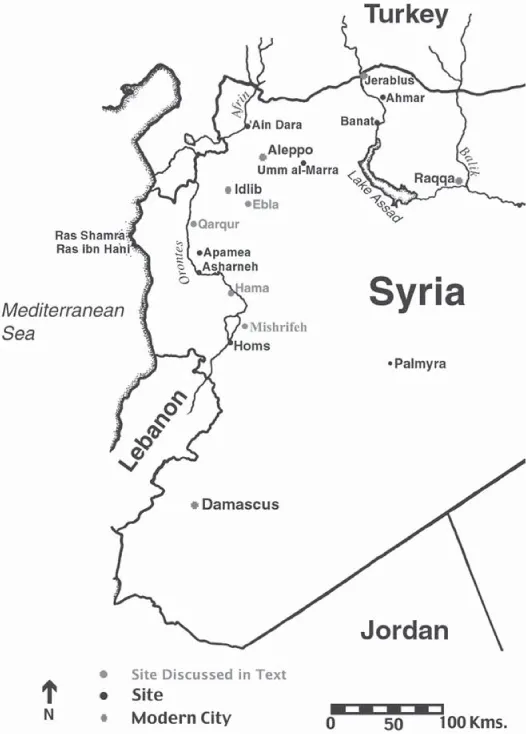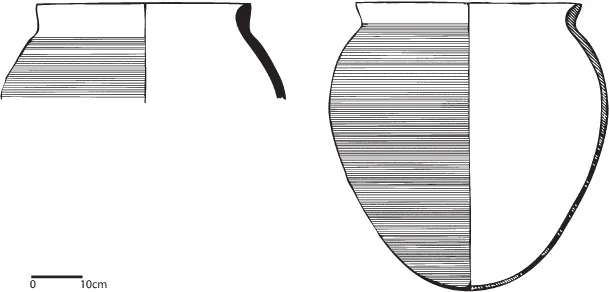![]()
CHAPTER 1
Culinary Preferences
Seal-Impressed Vessels from Western Syria as Specialized Cookware
Sarah R. Graff
BARRETT HONORS COLLEGE, ARIZONA STATE UNIVERSITY
In western Syria, a distinctive looking vessel has been found dating to the late third millennium BC. This vessel is known as the seal-impressed jar because it is often impressed with a cylinder seal on the rim or the neck. Seal-impressed jars are considered important for a number of reasons. First, they date to the end of the third millennium BC, a time when early states, such as Ebla, had begun to form in western Syria and subsequently declined. Second, seal-impressed vessels are found distributed widely and as a result are viewed as important economic markers linking different archaeological sites together. Third, seal-impressed vessels contain decorative seal impressions on them, which are viewed as traditional western Syrian symbolic iconography.
As economic markers, seal-impressed jars have become an important indication of a redistributive economy with the palace site of Ebla acting as the center. The most widely accepted view of history during this period (ca. 2400–2000 BC) is that western Syria was under the political and economic hegemony of the royal kingdom of Ebla (Archi 1992; Biga 1995; Matthiae 1981; Milano 1995; Steinkeller 1999). The provinces supplied goods to the central Ebla administration, and then these were reallocated in a redistributive system. Some archaeologists would describe the exchange system between Ebla and its territories as an instance of staple finance (Akkermans and Schwartz 2003). In this model, elites successfully mobilize and organize the labor of commoners, which produces a staple finance for the state. Specialists are given rations at the palace and administrators are given land, labor, and staples to support their maintenance (D’Altroy and Earle 1985). Seal-impressed jars play a crucial role in the construction of this view of Ebla’s political economy because some scholars regard them as archaeological evidence for redistribution. The jars are seen as containers of foodstuffs collected from the provinces and sent to Ebla in a redistributive system (Matthews 1996; Mazzoni 1984).
The seal-impressed jars are used as evidence for a redistributive economy because of their impressions, which are theorized as emblems. The style of the seal carving is considered a popular western Syrian style (Matthews 1996; Mazzoni 1993). The particular images of the impressions are also seen as common themes for north-central Syria (Mazzoni 1993). However, the styles and image themes are not seen as administrative or issued by a central place. Instead, these are considered indications that people in the provinces were producing them locally as a tool to facilitate staple finance. Due to the themes and the carving style used, the seal-impressed jars are interpreted as evidence for a limited number of workshops producing containers for agricultural products in the villages that would be collected and distributed by the central palace of Ebla (ibid.). The crucial link is the way that the seal impressions are theorized as emblems.
In order to study topics such as interactions between sites, domination, and identity, archaeologists who work in western Syria tend to look for emblems. Emblems are signs that represent things such as ideas, individuals, or institutions. They are signs that “identify” or signal the “identity” of things such as ideas, individuals, or institutions. Archaeologists working in western Syria identify emblems by looking for properties that render an object distinct or perhaps unusual, such as a decorative element or an image. Studying emblems has been an important aspect of research for many generations and has generated insight into the past. However, focusing on emblems has created a myopic view of the meaning of some objects, which has kept researchers from studying more mundane topics that could reveal a great deal of information about life in the past.
The study of emblems has been a prominent aspect of archaeological and art historical research in the Middle East. Since the earliest excavations in Mesopotamia that unearthed splendid objets d’art, the fascination with emblems, especially those connected to empire, was prominent. One prime example comes from the study of cylinder seals and their impressions. Cylinder seals are considered miniature works of art, yet also connected to the institutional administration of the state (Collon 1980; Pittman 1988). Cylindrically shaped seals were used in Mesopotamia as early as 3500 BC to impress clay sealings on doors to storage units or jars that contained foodstuff to prevent tampering. Later they were also used to seal written documents (Collon 1980; Pittman 1988). At the same time, many seals are exquisitely carved by expert engravers, and their artistic skills depict gods, kings, animals, and humans in banquet scenes, hunting scenes, and other ritualistic poses. It is no wonder that when such objects are found on excavations sites, the attention goes to them.
One of the problems with focusing on emblems is that the more prosaic dimensions of objects are overlooked. Could the seal-impressed jars be interpreted differently? If other aspects of seal-impressed jars are explored, does the centralized redistributive hypothesis still stand? Drawing on new evidence that suggests one type of seal-impressed jar from western Syria—the globular, corrugated, straight-rim jar—is actually a cooking pot, this paper explores the more commonplace evidence and nonemblematic aspects of seal-impressed jars. Although some ceramic types and wares are considered of the cooking pot variety, cookware has been poorly studied in western Syria. As discussed in the introduction to this volume, the reasons for this are multifold. One general reason includes the association of cookware with prosaic practices that, it is argued, would not provide information to answer “larger” (i.e., beyond the household) questions. This paper provides a different viewpoint by critically reassessing the centralized redistributive economy hypothesis and arguing that other aspects of the economy that are not controlled by the state should be taken into consideration. At the same time, this paper contributes to the broader themes of this volume by demonstrating how examining artifacts through the lens of cooking practices makes it possible to learn more about the social and economic factors that shaped the past. Studied as cooking pots, these containers emerge as a specialty item produced for knowledgeable cooks and their normative practices.
SEAL-IMPRESSED VESSELS
Seal-impressed vessels are ceramic containers that have an impression on the exterior surface made with a cylindrically shaped seal. The ceramic containers are generally medium to large in size and are classified as jars. The seal impressions are rolled either horizontally or vertically on the surface of the vessel. Sometimes the seal is rolled just once, leaving a short impression of a few centimeters in length, while other times it is rolled continuously, leaving a longer design.
Seal-impressed vessels are dated to the end of the third millennium BC or the Early Bronze IV period (EBIV). This period is a particularly curious one for researchers working in various countries of the Middle East. Complex social, economic, and political institutions emerged during the mid-third millennium BC in southeastern Anatolia, northern Iraq, and across Syria, and by the end of the period many urban sites had been destroyed by fire and abandoned (Akkermans and Schwartz 2003; Algaze et al. 1995; Archi 1993; Klengel 1992; Kouchoukos 1998; Matthiae 1981; Schwartz et al. 2000; Wattenmaker 1998; Weiss 1990; Wilkinson 1994). The EBIV period corresponds to a time of complexity and prosperity before a time of collapse and abandonment at some sites. Accordingly, distinctive emblematic artifacts from this archaeological period that link different sites together are seen as informative data that can help explain the development and possibly the demise of social, political, and economic institutions in the region.
Seal-impressed vessels have been found in archaeological excavations and surveys in the Mediterranean region and beyond. The practice of impressing pottery with cylinder seals is most common in Syria and Palestine (Ben-Tor 1978; Lapp 1989; Mazzoni 1992). Despite their vast geographical spread, the only piece of evidence that links these ceramic vessels together is the fact that they have seal impressions on them. The ceramic forms and fabrics vary not only from site to site but also within individual archaeological sites. In the Orontes Valley–Ebla region of western Syria (figure 1.1), only three ceramic forms are found with seal impressions: globular tripod jars with outward-swelling rims; globular, corrugated, straight-rim jars; and hole-mouth jars. Globular tripod jars with seal impressions are only found at Ebla and hole-mouth jars with impressions are found only at Hama, but the globular, corrugated, straight-rim jars are found at all sites. Since they link sites together in the Orontes Valley and western Syria more broadly, I will focus on the globular, corrugated, straight-rim jars (GCSRJ).
The GCSRJ are large (approximately 60 cm tall and 55 cm wide), without handles or lids, with a round body and a round bottom. The neck is short, the rim is simple and straight, and the exterior surface of the round body is finely corrugated with the corrugation ending at the neck (figure 1.2). Because of the shape and general characteristics of these vessels, the first archaeologist to write about them in detail, Stefania Mazzoni (1984, 1992, 1993), referred to them as “jars,” and that is how they have been described ever since. The GCSRJ have an impression on either the rim, neck, or sometimes the shoulder, made with a cylindrically shaped seal. The seal impression is usually about 2 centimeters thick and can be continuously rolled around the vessel to create a uniform decoration or can be rolled once or twice to create a shorter decorative image.
Seals were always carved out of hard materials in intaglio to leave an impression in relief. The seals discovered in Syria and Palestine were carved out of bone, ivory, chalk, ceramic, stone, and wood (Ben-Tor 1978). Those used to impress the GCSRJ might have been carved out of wood. One carbonized wooden seal was found at the site of ancient Ebla depicting a lizard, a rosette, and animals in three registers (Mazzoni 1984). These motifs are commonly found impressed into ceramic vessels in western Syria, although a direct match between the carbonized seal and a seal-impressed pot has not yet been found. In addition, many researchers have argued that the seals used to make the impressions on ceramic jars were made of wood because of the style of carving, which tends to be blocky with flat relief (Braidwood and Braidwood 1960; Mazzoni 1984). This is especially in comparison to the fine, detailed carvings made in stones such as serpentine or chlorite found in Mesopotamian contexts (Collon 1980). Another reason why the seals might have been made of wood is that the seals themselves are rarely found. The majority of the extant seals from Mesopotamia, Syria, and Palestine are made of stone, ivory, bone, or clay (ibid.; Lapp 1989), and these materials are less likely to disintegrate over the millennia in the Near East.
Figure 1.1. Map of sites in western Syria discussed in chapter.
Figure 1.2. Globular, corrugated, straight-rim jars from Qarqur (left) and Ebla (right).
The subjects of the seal impressions vary; some are simple geometric designs while others depict more intricate scenes of animals and humans. According to Mazzoni (1984, 1992), the iconography is part of a local, western Syrian glyptic tradition of the Early Bronze IV, dating to approximately 2400–2000 BC.
The meaning behind the glyptic seems to indicate specific ideas and shared knowledge from that time and place. It is difficult to determine if the geometric designs have a particular meaning, but the scenes of animals and humans appear to depict cult symbolism. For example, some impressions show human male figures with raised arms either with various animals or near buildings (figure 1.3) (Mazzoni 1984). These figures are usually interpreted as dancing, and similar dancing figures have been found in Palestine (Lapp 1989; Mazzoni 1984). There are also images of a “squatting woman” that Mazzoni (2002) argues was symbolic of fe...


